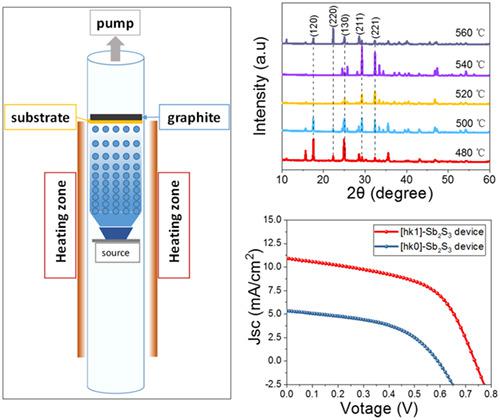当前位置:
X-MOL 学术
›
Prog. Photovoltaics
›
论文详情
Our official English website, www.x-mol.net, welcomes your feedback! (Note: you will need to create a separate account there.)
Controllable orientations for Sb2S3 solar cells by vertical VTD method
Progress in Photovoltaics ( IF 6.7 ) Pub Date : 2020-04-30 , DOI: 10.1002/pip.3278 Huan Zhang 1 , Shengjie Yuan 1, 2, 3 , Hui Deng 1, 3 , Muhammad Ishaq 1 , Xiaokun Yang 1 , Tengxuan Hou 1 , Usman Ali Shah 1 , Haisheng Song 1, 3 , Jiang Tang 1, 3
Progress in Photovoltaics ( IF 6.7 ) Pub Date : 2020-04-30 , DOI: 10.1002/pip.3278 Huan Zhang 1 , Shengjie Yuan 1, 2, 3 , Hui Deng 1, 3 , Muhammad Ishaq 1 , Xiaokun Yang 1 , Tengxuan Hou 1 , Usman Ali Shah 1 , Haisheng Song 1, 3 , Jiang Tang 1, 3
Affiliation

|
Antimony sulfide (Sb2S3) is a promising photoelectric material because of its wide bandgap approximately 1.7 eV for next‐generation solar cells, high optical absorption coefficient, and its green and earth‐abundant constituents. Different to traditional cubic structure photovoltaic materials, Sb2S3 holds one‐dimensional crystal structure and its thin film with [hk1] preferred orientation shows one‐order‐higher carrier transport mobility. However, all the reported Sb2S3 films exhibited [hk0] preferred orientation on CdS‐based superstrate device structure up to now. Thus, it is indispensable to study the controllable‐orientations Sb2S3 film deposition and the relationship between the orientation and performances. In this paper, we develop a vertical vapor transport deposition (V‐VTD) method, which can tune the preferred orientation of Sb2S3 thin film from [hk0] to [hk1] by reaction recipe monitoring. Combining the experiment results, a reasonable deposition/reevaporation competing model is suggested to explain above orientation conversion mechanism. The device efficiency increases from less than 2% to about 4% with the orientation of Sb2S3 film changing from [hk0] to [hk1]. By fine regulating the technique of deposition, the device with [hk1] orientation has better crystallinity, lower interface recombination, and higher built‐in voltage comparing with the [hk0] one. Finally, a champion power conversion efficiency (PCE) of 4.5% has been achieved, and the VOC of 730 mV is the top value among the Sb2S3 solar cells. The present versatile orientation tuning strategy could overcome the bottleneck of strong anisotropic materials and show high potential for noncubic material deposition and related optoelectronic device performance enhancement.
中文翻译:

垂直VTD法控制Sb2S3太阳能电池的方向
硫化锑(Sb 2 S 3)是一种有前途的光电材料,因为其下一代太阳能电池的带隙约为1.7 eV,光吸收系数高,并且具有绿色和地球丰富的成分。与传统的立方结构光伏材料不同,Sb 2 S 3具有一维晶体结构,其具有[hk1]优先取向的薄膜显示出一到更高的载流子迁移率。然而,到目前为止,所有报道的Sb 2 S 3薄膜在基于CdS的上覆层器件结构上均表现出[hk0]优先取向。因此,研究可控取向Sb 2 S 3必不可少膜的沉积以及取向与性能之间的关系。在本文中,我们开发了一种垂直气相传输沉积(V‐VTD)方法,该方法可以通过反应配方监控将Sb 2 S 3薄膜的首选取向从[hk0]调整为[hk1]。结合实验结果,提出了合理的沉积/再蒸发竞争模型来解释上述取向转化机理。随着Sb 2 S 3的取向,器件效率从不到2%提高到约4%电影从[hk0]更改为[hk1]。通过精细调节沉积技术,与[hk0]相比,具有[hk1]方向的器件具有更好的结晶度,更低的界面重组和更高的内置电压。最终,实现了4.5%的最佳功率转换效率(PCE),并且730 mV的V OC是Sb 2 S 3太阳能电池中的最高值。当前的通用取向调谐策略可以克服强各向异性材料的瓶颈,并显示出非立方材料沉积和相关光电器件性能增强的巨大潜力。
更新日期:2020-04-30
中文翻译:

垂直VTD法控制Sb2S3太阳能电池的方向
硫化锑(Sb 2 S 3)是一种有前途的光电材料,因为其下一代太阳能电池的带隙约为1.7 eV,光吸收系数高,并且具有绿色和地球丰富的成分。与传统的立方结构光伏材料不同,Sb 2 S 3具有一维晶体结构,其具有[hk1]优先取向的薄膜显示出一到更高的载流子迁移率。然而,到目前为止,所有报道的Sb 2 S 3薄膜在基于CdS的上覆层器件结构上均表现出[hk0]优先取向。因此,研究可控取向Sb 2 S 3必不可少膜的沉积以及取向与性能之间的关系。在本文中,我们开发了一种垂直气相传输沉积(V‐VTD)方法,该方法可以通过反应配方监控将Sb 2 S 3薄膜的首选取向从[hk0]调整为[hk1]。结合实验结果,提出了合理的沉积/再蒸发竞争模型来解释上述取向转化机理。随着Sb 2 S 3的取向,器件效率从不到2%提高到约4%电影从[hk0]更改为[hk1]。通过精细调节沉积技术,与[hk0]相比,具有[hk1]方向的器件具有更好的结晶度,更低的界面重组和更高的内置电压。最终,实现了4.5%的最佳功率转换效率(PCE),并且730 mV的V OC是Sb 2 S 3太阳能电池中的最高值。当前的通用取向调谐策略可以克服强各向异性材料的瓶颈,并显示出非立方材料沉积和相关光电器件性能增强的巨大潜力。


























 京公网安备 11010802027423号
京公网安备 11010802027423号